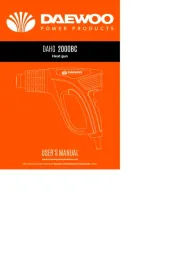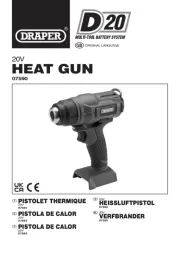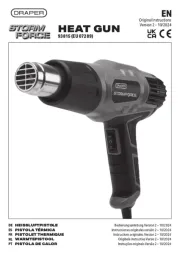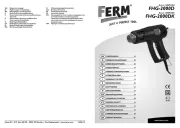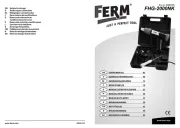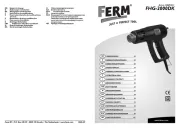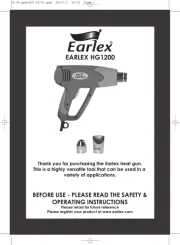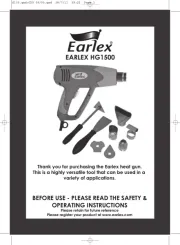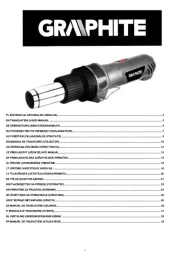
1
INDEX
1
. APPLICATION .......................................................................................................................................... 3
2
. DESCRIPTION .......................................................................................................................................... 3
3
. PACKAGE CONTENT LIST ...................................................................................................................... 3
4
. GENERAL POWER TOOL SAFETY WARNINGS
..................................................................................... 3
5
. ADDITIONAL SAFETY INSTRUCTIONS FOR HEAT GUNS
.................................................................. 5
6
. REMOVING PAINT
.................................................................................................................................. 5
7
. ASSEMBLY AND ADJUSTMENT
............................................................................................................ 5
8
. INSTRUCTIONS FOR USE ....................................................................................................................... 7
9
. MAINTENANCE AND CLEANING ........................................................................................................... 7
10
. TECHNICAL DATA ................................................................................................................................. 8
11
. ENVIRONMENT ..................................................................................................................................... 8
12
. CONFORMITY ........................................................................................................................................ 8
WARRANTY
................................................................................................................................................. 9
9.2 Lubrication
Your power tool requires no additional lubrication.
9.3 Cleaning
Keep the ventilation slots clear and regularly clean the housing with a soft cloth.
9.4 Cleaning
• Keep the ventilation slots of the machine clean to prevent overheating of the engine.
• Regularly clean the machine housing with a soft cloth, preferably after each use.
• Keep the ventilation slots free from dust and dirt.
• If the dirt does not come off use a soft cloth moistened with soapy water.
Never use solvents such as petrol, alcohol, ammonia water, etc. These solvents may damage the plastic
parts.
10. TECHNICAL DATA
Voltage : 220-240 V ~ 50 Hz
Power supply : 2000 W
Air temperature / Flow : I: 450 ºC; 300 L/min
II: 600 ºC; 500 L/min
11. ENVIRONMENT
Should your appliance need replacement after extended use, do not discard it with the household
rubbish but dispose of it in an environmentally safe way.
Waste produced by electrical machine items should not be handled like normal household rubbish.
Please recycle where facilities exist. Check with your Local Authority or retailer for recycling advice.
12. CONFORMITY
Confirms that this product, in the as brought into circulation through us, fulfils the requirements of
the following EEC directives:
8. INSTRUCTIONS FOR USE
• Always observe the safety instructions and applicable regulations.
• Use only one hand to hold the tool, do not place your other hand over the air vents
Prior to operation :
• Mount the correct accessory for the application.
• Set the desired air temperature.
8.1 Switching on and off
• To switch the tool on, set the on/off switch to position I/II. Some smoke may be emitted after
switching on; this does not indicate a problem.
• To switch the tool off, set the on/off switch to position I, and let it run for a few minutes. Then set
the on/off switch to position 0. Let the tool cool down before moving or storing it.
8.2 Temperature setting.
Turn ON/OFF switch to I/ II, depending on temperature you need. The heat gun will start to buzz.
8.3 Stripping paint
• Mount an appropriate accessory.
• Set a high air temperature.
• Switch the tool on.
• Direct the hot air onto the paint to be removed.
• When the paint softens, scrape the paint away using a hand scraper.
Do not strip metal window frames, as the heat may be conducted onto the glass and crack it.
When stripping other window frames, use the glass protection nozzle.
Do not keep the tool directed at one spot too long to prevent igniting the surface.
Avoid collecting paint on the scraper accessory, as it may ignite. If necessary, carefully remove paint
debris from the scraper accessory using a knife.
8.4 Stationary use
This tool can also be used in stationary mode.
• Secure the cable to prevent pulling the tool off the workbench.
• Carefully switch the tool on.
Make sure that the nozzle always points away from you and any bystanders.
Make sure not to drop anything into the nozzle.
8.5 cooling down
The nozzle and accessory become very hot during use. Let them cool down before attempting to
move or store the tool.
• To reduce the cooling time, set the on/off switch to position and let it run for a few minutes.
• Switch the tool off and let it cool down for at least 30 minutes.
9. MAINTENANCE AND CLEANING
Attention! Before performing any work on the equipment, pull the power plug.
9.1 Maintenance
Your Power Tool has been designed to operate over a long period of time with a minimum of mainte-
nance. Continuous satisfactory operation depends upon proper tool care and regular cleaning.
Setting Applications
I
• Drying paint, varnish color shade samples, filler, adhesives, construction joints and
stucco forms
• Drying wet timber prior to filling
• Removing stickers
• Joining adhesives-Large-surface gluing with contact adhesives, activation of pressure-sen
sitive adhesives, acceleration of bonding processes, releasing of bonding points as well as
releasing or bonding of edge band or veneer.
• Waxing and de-waxing
• Shrinking PVC wrapping and insulation tubes
• Defrosting of icy stairs and steps, door locks, trunk lids, car doors or water pipes, as
well as for defrosting refrigerators and ice boxes
II
• Welding of thermoplastic polymer, flooring materials of PVC and linoleum, PVC-coated
fabric, tarpaulins and foils
• Bending plastic pipes and sheets
• Soldering plumbing joints, tin, special silver solder, SMD elements, cable lugs
• Loosening rusted or tightly fastened nuts and bolts
• Removing old and even thick coatings of oil paint , lacquer, varnish and synthetic plaster
• Disinfection-With hot air of 600, you can quickly rid animal sties/stables of bacteria.
Woodworm infestation can be controlled (Caution: Danger of fire! Do not heat up the
wooden surface excessively).
If you are not sure about the correct setting, start with a low temperature setting and gradually increase
the temperature until you achieve optimum results
7.1 Mounting the correct accessory (if applicable)
Icon Description Purpose
Glass protection nozzle Protection windows when stripping frames
Spoon reflector nozzle Soldering pipes
Cone nozzle Welding, shrink sleeving (heat concentrated over small
Fish tail surface nozzle Drying, thawing (heat spread over wider area )
Scraper Stripping paint and varnish
• Make sure that the tool is switched off and the nozzle has cooled down.
• Falling down nozzle can set an object on fire. Nozzles must be mounted firmly and secure on the
unit.
• Touching a hot nozzle can lead to serious burns .Before attaching or replacing a nozzle, allow the
unit to cool down completely or use a suitable tool.
• A hot nozzle can set a surface on fire. Place down hot nozzles only on fire-proof surfaces.
• An incorrect or defective nozzle can lead to heat accumulation and damage the unit. Use only
original nozzles according to the table that are suitable for your unit.
1. APPLICATION
Your heat gun has been designed for stripping paint, soldering pipes, shrinking PVC, welding and
bending plastic as well as general drying and thawing purposes.
WARNING! Read this manual and general safety Instructions carefully before using the appliance, for
your own safety. Your power tool should only be passed on together with these instructions.
2. DESCRIPTION
1 Nozzle
2 Ventilation slots
3 On/off switch (0/I/II/III)
3. PACKAGE CONTENT LIST
• Remove all packing materials
• Remove remaining packaging and transit supports (if existing)
• Check the completeness of the packing content
• Check the appliance, the power cord, the power plug and all accessories for transportation
damages.
• Keep the packaging materials as far as possible till the end of the warranty period. Dispose it into
your local waste disposal system afterwards.
WARNING!
Packing materials are no toys! Children must not play with plastic bags! Danger of suffocation!
1 Heat gun
1 Set of accessories (Accessories may not be necessarily be included)
1 Instruction manual
When parts are missing or damaged, please contact your dealer.
4. GENERAL POWER TOOL SAFETY WARNINGS
Read all safety warnings and all instructions. Failure to follow all warnings and instructions may
result in electric shock, fire and/or serious injury. Save all warnings and instructions for future refe-
rence. The term “power tool” in the warnings refers to your mains operated (corded) power tool or
battery operated (cordless) power tool.
4.1 Work area
• Keep work area clean and well lit. Cluttered and dark areas invite accidents.
• Do not operate power tools in explosive atmospheres, such as in the presence of flammable
liquids, gases or dust. Power tools create sparks which may ignite the dust or fumes.
• Keep children and bystanders away while operating a power tool. Distractions can cause you to
lose control.
4.2 Electrical safety
• Power tool plugs must match the outlet. Never modify the plug in any way. Do not use any adapter
plugs with earthed (grounded) power tools. Unmodified plugs and matching outlets will reduce
risk of electric shock.
• Avoid body contract with earthed or grounded surfaces such as pipes, radiators, ranges and
refrigerators. There is an increased risk of electric shock if your body is earthed or grounded.
• Do not expose power tools to rain or wet conditions. Water entering a power tool will increase the
risk of electric shock.
• Do not abuse the cord. Never use the cord for carrying, pulling or unplugging the power tool. Keep
cord away from heat, oil, sharp edges or moving parts. Damaged or entangled cords increase the
risk of electric shock.
• When operating a power tool outdoors, use an extension cord suitable for outdoor use. Use of a
cord suitable for outdoor use reduces the risk of electric shock.
• If operating a power tool on a damp location is unavoidable, use a residual current device (RCD)
protected supply. Use of an RCD reduces the risk of electric shock.
4.3 Personal safety
• Stay alert, watch what you are doing and use common sense when operating a power tool. Do not
use a power tool while you are tried or under the influence of drugs, alcohol or medication. A
moment of inattention while operating power tools may result in serious personal injury.
• Use safety equipment. Always wear eye protection. Safety equipment such as dust mask,
non-skid safety shoes, hand hat, or hearing protection used whenever conditions require will
reduce personal injuries.
• Avoid accidental starting. Ensure the switch is in the off position before plugging in.
Carrying power tools with your finger on the switch or plugging in power tools that have the switch
on invites accidents.
• Remove any adjusting key or wrench before turning the power tool on. A wrench or a key left
attached to a rotating part of the power tool may result in personal injury.
• Do not overreach. Keep proper footing and balance at all times. This enables better control of the
power tool in unexpected situations.
• Dress properly. Do not wear loose clothing or jewellery. Keep your hair, clothing and gloves away
from moving parts. Loose clothes, jewellery or long hair can be caught in moving parts.
• If devices are provided for the connection of dust extraction and collection facilities, ensure these
are connected and properly used. Use of these devices can reduce dust related hazards.
4.4 Power tool use and care
• Do not force the power tool. Use the correct power tool for your application. The correct power
tool will do the job better and safer at the rate of which it was designed.
• Do not use the power tool if the switch does not turn it on and off. Any power tool that cannot be
controlled with the switch is dangerous and must be repaired.
• Disconnect the plug from the power source before making any adjustments, changing
accessories, or storing power tools. Such preventive safety measures reduce the risk of starting
the power tool accidentally.
• Store idle power tool out of the reach children and do not allow persons unfamiliar with the power
tool of these instructions to operate the power tool. Power tools are dangerous in the hands of
untrained users.
• Maintain power tools. Check for misalignment or sticking of moving parts, breakage of parts and
other condition that may affect the power tool’s operation. If damaged, have the power tool repai
red before use. Many accidents are caused by poorly maintained power tools.
• Keep cutting tools sharp and clean. Properly maintained cutting tools with cutting edges are less
likely to stick and are easier to control.
• Use the power tool, accessories and tool bits etc., in accordance with these instructions and in the
manner intended for the particular type of power tool, taking into account the working conditions
and the work to be performed. Use of the power tool for operations different from intended could
lead to a hazardous situation.
4.5 Service
Have your power tool serviced by qualified repair person using only identical replacement parts. This
will ensure that the safety of the power tool is maintained.
5. ADDITIONAL SAFETY INSTRUCTIONS FOR HEAT GUNS
• Do not place your hand over the air vents or block the vents in any way.
• The nozzle and accessories of this tool become extremely hot during use. Let these parts cool
down before touching.
• Always switch the tool off before putting it down.
• Do not leave the tool unattended while it is switched on.
• A fire may arise if the appliance is not used with care.
• Heat may be conducted to combustible materials that are out of sight. Do not use in a damp
atmosphere, where flammable gases may be present or near combustible materials.
• Allow the tool to cool fully before storing.
• Ensure adequate ventilation as toxic fumes may be produced.
• Do not use as a hairdryer.
• Do not obstruct either the air intake or nozzle outlet, as this may cause excessive heat build up
resulting in damage to the tool.
• Do not direct the hot air blast at other people.
• Do not touch the metal nozzle as it becomes very hot during use and remains hot for up to 30
minutes after use.
• Do not place the nozzle against anything while using or immediately after use.
• Do not poke anything down the nozzle as it could give you an electric shock. Do not look down the
nozzle while the unit is working because of the high temperature being produced.
• Do not allow paint to adhere to the nozzle or scraper as it could ignite after some time.
6. REMOVING PAINT
• Do not use this tool to remove paint containing lead. The peelings, residue and vapors of paint
may contain lead, which is poisonous. Any pre-1960 building may have been painted in the past
with paint containing lead and covered with additional layers of paint.
Once deposited on surfaces, hand to mouth contact can result in the ingestion of lead.
Exposure even to low levels of lead can cause irreversible damage to the brain and nervous system.
Young and unborn children are particularly vulnerable.
• When removing paint., ensue that the work area is enclosed. Preferably wear a dust mask.
• Do not burn the paint. Use the scraper and keep the nozzle at leaf 25 mm away from the painted
surface. When working in a vertical direction, work downwards to prevent paint from falling into
the tool and burning.
• Dispose of all paint debris safely and ensure that the work area is thoroughly cleaned after com
pleting the work.
7. ASSEMBLY AND ADJUSTMENT
Prior to assembly and adjustment always unplug the tool
The air temperature can be adjusted to suit a wide range of applications. The table below suggests
settings for different applications.

